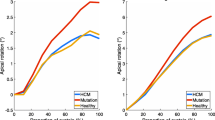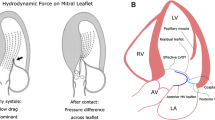Abstract
Heart failure has been divided into several different forms depending on etiology, clinical course and pathophysiology of left ventricular (LV) dysfunction. Systolic and diastolic dysfunction are characterized by a reduced cardiac output with normal (=diastolic dysfunction) or depressed (=systolic dysfunction) LV pump function.
New diagnostic techniques such aS magnetic resonance imaging (MRI) allow to determine noninvasively LV 3D motion by labelling specific myocardial regions (=myocardial “tagging”) with a rectangular or radial grid. From the deformation of this grrd rotational and translational motion of the heart can be derived. A “wringing” motion of the left ventricle has been described during systole which includes a clockwise rotation at the base and a counter-clockwise rotation at the apex. During diastole, an “untwisting” motion has been demonstrated. In the normal heart, diastolic “untwisting” occurs primarily during isovolumic relaxation, analogous to the systolic “wringing” which takes place mainly during isovolumic contraction. A prolongation of the “untwisting” motion was found in the hypertrophied (aortic stenosis) and hibernating myocardium.
Thus, heart failure is associated with profound alterations in the mechanical function of the heart which are manifested by changes in systolic “wringing” and diastolic “untwisting” motion.
Similar content being viewed by others
References
Cohn JN, Johnson GJ, Veterans Administration Cooperative Study Group (1990) Heart failure with normal ejection fraction: The V-HeFT study. Circulation 81 (Suppl III): III-48–III-53
Lindroos M, Kupari M, Tilvis R, Heikkila J (1995) Heart failure in the aged: Systolic or diastolic left ventricular dysfunction? Eur Heart J 16 (abstract): 190
Topol EJ, Traill TA, Fortuin NJ (1985) Hypertensive hypertrophic cardiomyopathy of the elderly N Engl J Med 312: 277–83
Lorell BH, Grossman W (1987) Cardiac hypertrophy: The consequences for diastole. J Am Coll Cardiol 9: 1189–93
Packer M (1992) Pathophysiology of chronic heart failure, Lancet 340: 88–92
Grossman W (1991) Diastolic dysfunction in congestive heart failure. N Engl J Med 325: 1557–64
Gilbert JC, Glantz SA (1989) Determinants of left ventricular filling and of the diastolic pressure-volume relation. Circ Res 64: 827–52
Gaasch WH, Blaustein AS, Andrias EW et al. (1980) Myocardial relaxation. Part II: Hemodynamic determinants of rate of left ventricular isovolumic pressure decline. Am J Physiol 239: H1–6
Brutsaert D, Rademakers FE, Sys SU (1984) Triple control of relaxation: Implications in cardiac disease. Circulation 69: 190–6
Yellin EL, Hori M, Yoran C, Sonnenblick EH, Gabbay S, Frater RW (1986) Left ventricular relaxation in the filling and non-filling intact canine heart. Am J Physiol 250: H620–9
Villari B, Campbell SE, Hess OM (1993) Influence of collagen network on left ventricular systolic and diastolic function in aortic valve disease. J Am Coll Cardiol 22: 1477–84
Brilla CG, Maisch B (1994) Regulation of the structural remodeling of the myocardium: From hypertrophy to heart failure. Eur Heart J 15 (Suppl D): 45–52
Spirito B, Muron BJ (1988) Doppler echocardiography for assessing left ventricular diastolic dysfunction. Ann Intern Med 109: 122–6
Hatle L (1993) Doppler echocardiographic evaluation of diastolic function in hypertensive cardiomyopathies. Eur Heart J 14 Suppl J: 88–94
Ingels NB, Daughters GT, Stinson EB, Alderman EL (1975) Measurement of midwall myocardial dynamics in intact man by radiography of surgically implanted markers. Circulation 52: 859–67
Carlsson E, Milne ENC (1967) Permanent implantation of endocardial tantalum screws: A new technique for functional studies of the heart in the experimental animal. J Can Assoc Radiol 19: 304–9
Myers JH, Stirling MC, Choy M, Buda AJ, Gallagher KP (1986) Direct measurement of inner and outer wall thickening dynamics with epicardial echocardiography. Circulation 74: 164–72
Zerhouni EA, Parish DM, Rogers WJ (1988) Tagging with MR imaging: A method for noninvasive assessment of myocardial motion. Radiology 169: 59–63
Axel L, Dougherty L (1989) Heart wall motion: Improved method of spatial modulation of magnetization for MR imaging. Radiology 172: 349–50
Fischer SE, McKinnon GC, Scheidegger MB, Prins W, Meier D, Boesiger P (1994) True myocardial motion tracking. Magn Reson Med 31 (4): 401–13
Nagel E, Stuber M, Fischer SE, Boesiger P, Hess OM (1995) Myocardial tagging: A new approach for the evaluation of right ventricular function. Circulation (abstract suppl) 92 (8): I-509
Maier SE, Fischer SE, McKinnon GC, Hess OM, Krayenbuehl HP, Boesiger P (1992) Evaluation of left ventricular segmental wall motion in hypertrophic cardiomyopathy with myocardial tagging. Circulation 86: 1919–28
Rademakers FE, Buchalter MR, Rogers WJ et al. (1992) Dissociation between left ventricular untwisting and filling; accentuation by catecholamines. Circulation 85: 1572–81
Rogers WJ, Shapiro EP, Weiss JL et al. (1991) Quantification of correction for left ventricular systolic long-axis shortening by magnetic resonance tissue tagging and slice isolation. Circulation 84: 721–31
Unterberg R, Plesak L, Voelker W, Karsch KR (1988) Quantitative segmental analysis of wall function of the right ventricle in probands with healthy hearts. Z Kardiol 77: 120–4
Yun KL, Niczyporuk MA, Daughters GT et al. (1991) Alterations in left ventricular diastolic twist mechanics during acute human cardiac allograft rejection. Circulation 83: 962–73
Author information
Authors and Affiliations
Rights and permissions
About this article
Cite this article
Matter, C., Nagel, E., Stuber, M. et al. Assessment of systolic and diastolic LV function by MR myocardial tagging. Basic Res Cardiol 91 (Suppl 1), 23–28 (1996). https://doi.org/10.1007/BF00795358
Issue Date:
DOI: https://doi.org/10.1007/BF00795358




